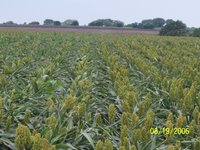I've been visiting with local farmers and extension folks the last couple of days about the status of the wheat crop. According to the experts around the state, this part of Kansas has been hit about the hardest of any area, though the damage cuts a swath from North Central Kansas towards Pratt, southeasterly through Kingman and continues into Northeastern Oklahoma. Everything east of that line has received damage, ranging from moderate to total freeze out.
Having said that, one extension expert was cautiously optimistic as he noted in his travels and wheat inspections that the wheat crown is putting out new tiller spikes. He suggests we wait another ten days to see the extent of the emergence before deciding what to do.
Having said that as well, the emerging tillers will be numerous, yet will be very short and will probably head out two weeks later than the normal May 1 timeframe and the critical fill will be between June 1 and the 10th. The weather can turn hot and dry then, turning the late filling heads into light grain. He gives it a 50-50 chance of a normal, average yield.
I'm willing to wait. Actually, I have no other plausible option. My herbicide application on the wheat in mid March requires a 120 day delay before planting beans or milo. I used an extra light application so I may be able to plant 30 days earlier than the July 15 date, but that's not much consolation as it eliminates normal planting dates for either crop.
So, there you have it. My opinion of the grain trade taking a wait and see attitude is that they are misreading this market and the freeze much like they misread the freeze a decade ago. The odds of that optimum recovery happening again is too high. The freeze ocurred earlier giving the tillers a head start. The weather cooperated as well, with cool spring winds and frequent rains without the hassle of high temperatures that normally ocurr in Kansas.
I'll have before and after pictures posted by this weekend when the tillers have emerged a little more.


















































